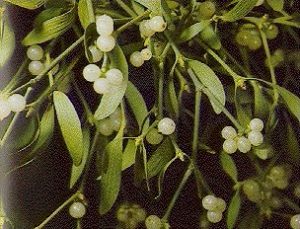
American Mistletoe
For a complete list of plants toxic to dogs and cats, please follow this link.
Many people are decorating their homes for the holidays, but pet owners should be aware that some plants used for holiday decorating can be dangerous to cats and dogs. Understanding which plants are toxic, and which are not, can help bring home the festive spirit and avoid danger for pets.
One of the most popular holiday plants often considered poisonous are poinsettias. But in fact, they are “non” to “mildly” toxic and do not deserve their bad reputation. Pets that ingest poinsettias generally have no clinical signs or mild gastrointestinal discomfort. A mild rash may develop if rubbed on the skin, but they are considered safe to keep in the home.
Dr. Dorothy Black, clinical assistant professor at the Texas A&M University College of Veterinary Medicine and Biomedical Sciences (CVM), explained, “Poinsettias are usually referred to as highly toxic, but they really aren’t. Feel free to display them at Christmas.”
Christmas trees are also generally safe for pets. However, pine needles can cause damage to eyes if pets should run into the tree, such as a corneal laceration. Should pets ingest the sap produced by the tree, mild gastrointestinal discomfort may occur, but natural trees are generally non-toxic for cats and dogs.
Mistletoe, on the other hand, can be quite poisonous to pets. If ingested, pets may experience gastrointestinal upset, or show clinical signs of poisoning such as a change in mental function, difficulty breathing, or a low heart rate.
“If you see these symptoms in your pet and suspect or know they ingested mistletoe, you should seek veterinary assistance as soon as possible,” Black said. “Mistletoe shouldn’t be used where pets could possibly reach it.”
Another holiday decorative plant, holly, can be dangerous for pets and is considered poisonous. Clinical symptoms may be displayed as vomiting, diarrhea, decreased energy, and general upset stomach. Owners should seek veterinary assistance if they suspect their pets of ingesting holly.
Amaryllis and Daffodils are also considered poisonous for pets. If ingested, pets may vomit, appear depressed, or show signs of a painful abdomen and a loss of appetite.
“Some pets who consume amaryllis or daffodils will show symptoms of tremors,” Black said. “This can be a sign of severe toxicity.”
Lilies are particularly toxic to cats. The ingestion of any part of any type of lily can lead to kidney failure. The clinical signs can include vomiting, depression, or loss of appetite. If you suspect your cat of ingesting lilies, you should contact your veterinarian immediately. There is no antidote, and intense supportive care is needed for cats to recover.
“The more toxic the plant, the more careful you should be with displaying them in your home. While Poinsettias and Christmas trees are generally safe for pets, holly, mistletoe, amaryllis, daffodils, and lilies should be considered quite toxic,” Black said. “Pets should not be allowed to come in contact with poisonous holiday plants, and if they are displayed in the home they should be kept out of reach, and pet’s behavior should be monitored to make sure they do not show symptoms of poisoning.”
Bright ornamental plants are a great way to dress up the house during the holidays and bring life to your home during the winter. But pet owners should be aware that many of these common plants are poisonous to their furry family members.
Toxicity ranges from mild to severe, and the amount of plant your pet eats determines how sick it might become. In general, gastrointestinal upset is the most common result, but if enough plant material is eaten, seizures, coma, or death is possible.
Naturally curious puppies and kittens might want to sample some of the new-in-the-house greens. The dose is size-dependent, so puppies and kittens are most often at greatest risk for plant poisonings.
Poinsettia Plant
Many people associate the poinsettia plant with extreme toxicity, but this is not true. In fact, it is largely an urban legend, dating back to 1919. The sap of poinsettias is considered to be mildly toxic or irritating and could cause nausea or vomiting if it’s eaten but not death.
Mistletoe and Holly
Mistletoe and holly are considered to be moderate to severely toxic, and you should call your veterinarian or poison control center immediately for specific advice if your pet eats either one of these very common holiday plants.
Lilies and Daffodils
Plant bulb kits featuring amaryllis, other plants in the lily family, narcissus, and other plants in the daffodil family are a popular gift and decor items during the holiday season. Pet owners should be aware that these plants are very toxic to cats. They sometimes can cause severe symptoms of gastrointestinal distress, cardiac arrhythmias, kidney failure, convulsions, and death. Daffodils are toxic to both dogs and cats, especially the bulbs.
Christmas Trees
Don’t forget about the Christmas tree. Evergreen Christmas trees are considered to be mildly toxic. The fir tree oils can irritate the mouth and stomach, causing excessive drooling or vomiting. The tree needles are not easily digested, either, and can cause GI irritation, vomiting, gastrointestinal obstruction, or puncture. As noted earlier, the amount of trouble depends on how much is consumed. Many times, pets don’t consume mass quantities of tree material, but it is still good to be aware of the risk.
Common Clinical Signs
Signs most commonly seen with toxic plant ingestion relate to the gastrointestinal tract: vomiting, diarrhea, abdominal pain, and sometimes excessive salivation (drooling). In some cases, such as holly berry ingestion, tremors or seizures could occur, followed by coma and death.
Watch Your Plants and Your Pets
Monitor your pet’s interest in the plants. To be 100 percent safe, do not bring toxic live plants into your house. If you are unsure about a plant, look it up to check toxicity. Monitor your pet’s interest in eating plants and place plants out of reach. Check the plants for any signs of chewing or missing leaves.
This article has been provided for informational purposes only. If your pet is showing any signs of illness, please consult a veterinarian as quickly as possible.
If you suspect your pet is sick, call your vet immediately. For health-related questions, always consult your veterinarian, as they have examined your pet, know the pet’s health history, and can make the best recommendations for your pet.
“The more toxic the plant, the more careful you should be with displaying them in your home. While Poinsettias and Christmas trees are generally safe for pets, holly, mistletoe, amaryllis, daffodils, and lilies should be considered quite toxic,” Black said. “Pets should not be allowed to come in contact with poisonous holiday plants, and if they are displayed in the home they should be kept out of reach, and pet’s behavior should be monitored to make sure they do not show symptoms of poisoning.”
Sources:








